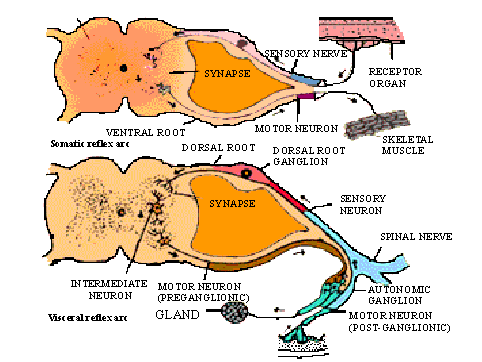|
PinkMonkey Online Study Guide-Biology
23. 4 Reflex Action - Mechanism of Nervous Action
The term reflex action refers to a rapid,
automatic unlearned response to a stimulus. These actions are involuntary
as opposed to voluntary actions, which are governed by willful or
conscious control of the animal.

Click here for enlargement
Figure 23.8 Reflex arcs
A familiar example of the reflex action in man is the
"knee jerk" reflex or the "hand withdrawal" after
pin prick. It is common understanding that if suddenly one is pricked
by a sharp object such as a pin one immediately retracts from the object.
In such actions, the impulses are carried by the sensory fibers from
the receptor organ to the central nervous system and back to the
effector organ. The path or the route through which the impulses
travel from the receptor organ (via the Central Nervous System) is called
a reflex arc.
Reflex hand withdrawal - Stimulus ® Receptor organ (skin)
(pin prick) ¯
Effector organ ¬ Motor fibers ¬ C.N.S. ¬ Sensory fibers
(Skeletal muscles)
If the controlling center of the reflex arc is located
in the brain it is called cerebral reflex. If it is located in
the spinal cord, it is called spinal reflex.
The reflex arcs are of two types.
1) Somatic reflex arc involving effector organs
located in (soma) body structures, e.g. skeletal muscles.
2) Visceral reflex arc involves effectors located
in the visceral organs; e.g. glands or smooth muscles.
Components of the reflex arcs
| Somatic reflex arc (Figure
23.8) |
Visceral reflex
arc |
| 1. Receptor organ (e.g.) skin |
1. Receptor organ (e.g. Epithelial
lining of the gut) |
| 2. Somatic sensory or afferent
neuron (unipolar) |
2. Visceral sensory or afferent
neuron (unipolar) |
| 3. Intermediate neuron (Multipolar) |
3. Visceral motor of efferent
(Pre-ganglionic) |
| 4. Somatic motor or efferent
neuron (Multipolar) |
4. Visceral motor or efferent
neuron (Post-ganglionic) |
| 5. Effector organ (e.g. Skeletal
muscles) |
5. Effector organ (e.g. gland
or smooth muscles) |
A simple reflex arc consists of only one sensory neuron
and one motor neuron (monosynaptic reflex). But in a majority of reflexes,
a sensory neuron influences several motor neurons through intermediate
(association) neurons of the spinal cord. This forms a complex reflex
arc, or polysynaptic reflexes.
Some common examples of reflex actions are knee jerk reflex, contraction
of iris diaphragm (i.e. narrowing of pupil in response of intense light)
blinking of eye lids when aimed at, withdrawal of hand on pin prick, sneezing,
and secretion of saliva at the sight or smell of food.
[next page]
|
Table of Contents
23.0 Introduction
23.1 Central nervous system
23.2 The automatic nervous system
23.3 Receptors and effects
23.4 Reflex action - mechanism of nervous action
Chapter 24
|